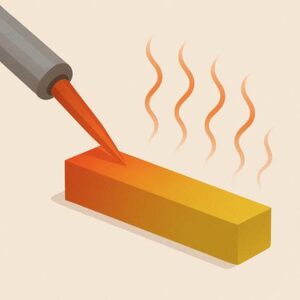Lut odgrywa kluczową rolę w montażu wszystkiego, od smartfonów po przemysłowe urządzenia sterujące, tworząc silne połączenia elektryczne i mechaniczne między komponentami i płytkami drukowanymi (PCB).
Ten przewodnik zawiera prosty przegląd dla początkujących, w tym czym jest lut, co robi topnik i jakie są najpopularniejsze formy lutowania. Dowiedz się, jak technicy używają tych materiałów w procesach montażu elektroniki, takich jak lutowanie na fali, lutowanie rozpływowe i lutowanie ręczne.

Czym jest lut?
Lut to stop metalu używany do łączenia ze sobą dwóch lub więcej powierzchni metalowych. Zwykle składa się z metalu nieszlachetnego, takiego jak cyna, w połączeniu ze srebrem, miedzią, bizmutem, ołowiem lub innymi metalami elementarnymi.
Zaprojektowany do topienia w stosunkowo niskiej temperaturze, lut umożliwia łączenie różnych powierzchni metalowych bez ich topienia lub uszkadzania innych materiałów znajdujących się w pobliżu, takich jak elementy płytki drukowanej. Po schłodzeniu lut tworzy silne połączenie elektryczne i mechaniczne.
W produkcji elektroniki technicy najczęściej używają lutu do łączenia komponentów z płytką drukowaną (PCB). Może się to odbywać poprzez lutowanie na fali, lutowanie ręczne lub zrobotyzowane, lub poprzez drukowanie pasty lutowniczej.
Lutowanie w produkcji elektroniki
Lut do produkcji elektroniki jest dostępny w kilku formach, z których każda jest przeznaczona do określonych procesów. Najpopularniejsze formy obejmują:
- Pręt lutowniczy: Solidny, prostokątny lub wlewkowy kawałek stopu przeznaczony głównie do lutowania na fali.
- Drut lutowniczy: Szpula drutu, która często zawiera rdzeń z topnikiem do lutowania ręcznego i zrobotyzowanego.
- Pasta lutownicza: Mieszanina sproszkowanego stopu lutowniczego i topnika o konsystencji pasty do zastosowań w technologii montażu powierzchniowego (SMT).
Czym jest Flux?
W poprzedniej sekcji wspomnieliśmy o słowie flux. Flux to substancja, która idzie w parze ze stopami lutowniczymi w procesie lutowania. Jest to chemiczny środek czyszczący stosowany w celu poprawy jakości i niezawodności połączenia lutowanego.
Topnik usuwa tlenki z powierzchni metalowych i zapobiega dalszemu utlenianiu podczas podgrzewania, tworząc barierę ochronną. Umożliwia on również płynny przepływ stopionego lutowia i skuteczne łączenie.
Istnieją trzy podstawowe typy chemia topników:
- Topniki na bazie kalafonii są najczęściej wykorzystywane w zastosowaniach wojskowych i lotniczych. Technicy muszą zazwyczaj usuwać pozostałości tych topników po lutowaniu płyt za pomocą specjalnych środków czyszczących.
- Rozpuszczalne w wodzie pozostałości topnika również wymagają czyszczenia, ale są one przeznaczone do czyszczenia za pomocą zwykłego płukania wodą.
- Topniki nie wymagające czyszczenia są najbardziej popularne w branży. Jak sama nazwa wskazuje, pozostałości pozostawione przez te topniki nie wymagają czyszczenia. Został on zaprojektowany w taki sposób, aby można go było pozostawić bez powodowania problemów z niezawodnością elektryczną. Jednak niektórzy użytkownicy nadal decydują się na czyszczenie pozostałości topnika, a istnieją specjalne chemikalia czyszczące przeznaczone również do tego procesu.
Topnik występuje również w kilku formach. Najpopularniejsze formy to topnik w płynie, topnik rdzeniowy oraz topnik w paście lub lepki topnik. Topnik w płynie jest zwykle dostępny w dzbankach i ma przezroczysty wygląd. Stosowany jest głównie w lutowaniu na fali, gdzie jest spieniany lub natryskiwany na płytkę drukowaną przed lutowaniem.
Topnik rdzeniowy to gęsty, przypominający pastę topnik, który biegnie wzdłuż środka drutu lutowniczego z rdzeniem. Technicy używają go głównie do lutowania ręcznego i zrobotyzowanego
Topnik w paście lub lepki topnik to gęsty topnik o konsystencji pasty, który może mieć kolor od białawego do ciemnobursztynowego/brązowego. Topnik stanowi bazę dla pasty lutowniczej, ale jest również dostępny samodzielnie do utrzymywania komponentów na miejscu podczas innych procesów.
Pręt lutowniczy i płynny topnik w lutowaniu na fali
Lutowanie na fali jest szybkim procesem dla zespołów z otworami przelotowymi, gdzie fala lutuje wyprowadzenia komponentów (włożone do otworów w płytce drukowanej) od spodu. W tej metodzie stały pręt lutowniczy jest topiony w podgrzewanym garnku, tworząc stojącą falę stopionego lutowia. Maszyny najpierw pokrywają zespoły płynnym topnikiem, a następnie podgrzewają i przepuszczają falę, która dotyka tylko spodniej strony płytki.
Roztopiony lut nie uszkadza płytki ani komponentów dzięki ścisłej kontroli procesu. Grzałki stopniowo podgrzewają płytkę, zanim dotrze ona do fali, a czas ekspozycji jest krótki. Lut przylega tylko do odsłoniętych metalowych padów i wyprowadzeń komponentów ze względu na napięcie powierzchniowe i aktywność topnika. Technicy używają lutowania na fali głównie w przypadku dużych serii produkcyjnych płytek PCB z wieloma elementami przelotowymi, takimi jak zasilacze lub przemysłowe elementy sterujące.
Lutowanie drutem: Procesy ręczne i zautomatyzowane
Drut lutowniczy, często pokryty topnikiem, jest wszechstronną formą używaną przez techników do ręcznego montażu, przeróbek lub selektywnej automatyzacji. Podczas lutowania ręcznego technik nakłada drut bezpośrednio na złącze za pomocą rozgrzanej lutownicy, aby precyzyjnie kontrolować miejsce i ilość osadzonego lutowia. Wbudowany topnik czyści powierzchnie podczas topnienia lutu, pomagając mu związać się z metalowymi padami i przewodami.
Zautomatyzowane lutowanie drutowe wykorzystuje programowalny sprzęt, taki jak ramiona robotów z grotami lutowniczymi, do wykonywania spójnych, powtarzalnych połączeń w produkcji wysokonakładowej lub średnioseryjnej. Metoda ta jest idealna, gdy tylko niektóre punkty na płytce wymagają lutowania lub gdy komponenty przelotowe są używane obok części do montażu powierzchniowego.
Lutowanie drutem zapewnia elastyczność i kontrolę, dzięki czemu jest preferowaną metodą w przypadku prototypów, napraw i złożonych lub niewielkich serii.
Lutowanie pastą lutowniczą
Technologia montażu powierzchniowego (SMT) jest najpopularniejszą metodą montażu nowoczesnej elektroniki. Zamiast wkładać przewody komponentów do otworów, komponenty SMT są umieszczane bezpośrednio na padach na powierzchni płytki drukowanej. Do tworzenia połączeń elektrycznych i mechanicznych producenci używają pasty lutowniczej, gęstej mieszanki sproszkowanego stopu i topnika.
Technicy nakładają pastę za pomocą procesu drukowania szablonowego. Umieszczają szablon ze stali nierdzewnej z wycięciami dopasowanymi do płytki na górze, a rakla przesuwa pastę w poprzek, wypełniając otwory. Po usunięciu szablonu na padach pozostają precyzyjne osady pasty lutowniczej.
Następnie maszyna pick and place umieszcza komponenty na paście, a lepkość pasty utrzymuje je na miejscu. Następnie technik przepuszcza płytkę przez piec rozpływowy. Piec ten stopniowo podgrzewa zespół, topiąc lut i tworząc trwałe połączenia podczas chłodzenia. Lutowanie SMT umożliwia kompaktowe zespoły o wysokiej gęstości z doskonałą powtarzalnością i jest niezbędne dla większości nowoczesnej elektroniki użytkowej i przemysłowej.
Dowiedz się więcej
Jeśli chcesz dowiedzieć się więcej o lutowiu i procesie lutowania, sprawdź dodatkowe AIM Solder wpisy na blogu jak również naszą kolekcję dokumenty techniczne.





